Starbucks fights the midlife crisis: it can't just rely on large-scale stores, and then it's time to play the emotional card?
Abstract: Starbucks Zhenxuan store, flagship store, coffee roaster. Behind these new store formats is Starbucks' comprehensive efforts in space design, food and beverage types, consumer experience and digitization.
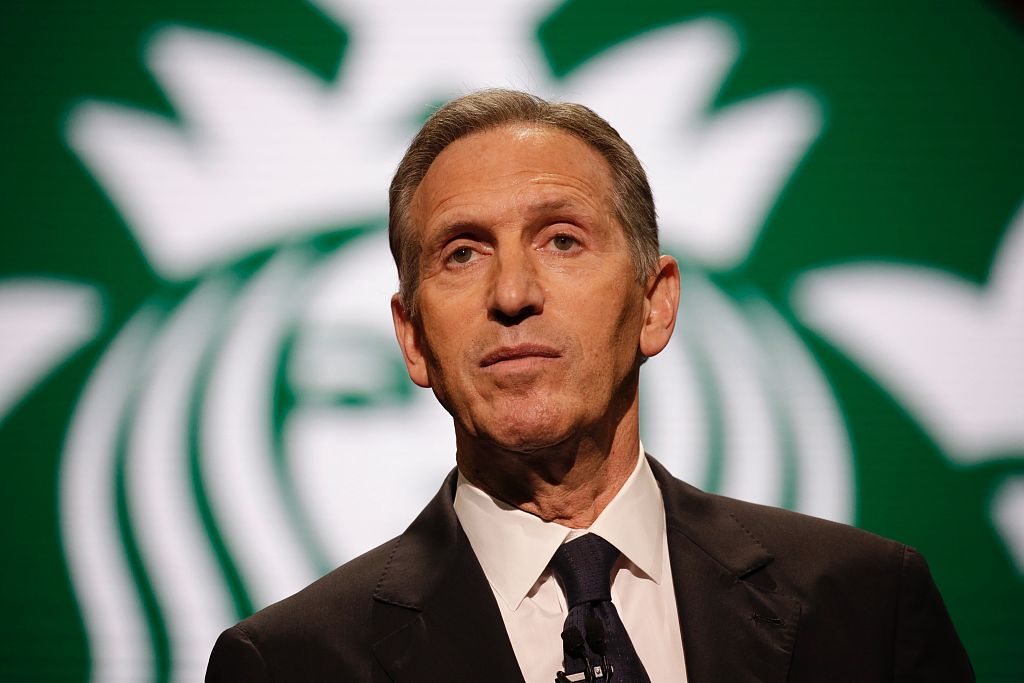
Howard Schultz (Howard Schultz), chairman and founder of Starbucks
Howard Schultz said: "the retail industry is in urgent need of a big adjustment, a lot of physical stores will be closed, we have to build better, emotional, romantic stores."
High-end Starbucks stores with a strong brand base may become the new "mecca for online celebrities", but it is still unknown whether Chinese consumers' enthusiasm for this experience can continue and what impact and change it will have on other ordinary stores.
In China, where there is no coffee culture, when consumers want coffee, or even just find a place to rest their feet and surf the Internet, the highly standardized Starbucks has become an easy-to-reach safe choice.
"Princi Foods will further enhance the experience of customers at Starbucks Coffee Roasters and selection restaurants-whether it's breakfast, lunch or dinner."
Wen / World Internet businessman reporter he Chengxuan
Figure / bag
Starbucks, born in 1971, is suffering from a midlife crisis.
Over the past 46 years, the multinational coffee shop chain, which was born in the United States, initially sold only coffee beans, expanded rapidly after being adjusted to its current format, and became one of the symbols of American life. According to Starbucks' report for the fourth quarter of fiscal year 2016, it had 25085 stores worldwide as of October 2, 2016, with a net increase of 981 stores in China / Asia-Pacific region, making it a strong growth engine.
For a long time, its business model has become a successful model of the retail industry and has been widely praised. However, even if it tries to form an alliance with supermarkets, bookstores and other industries, and tries to appear in front of consumers with a compound image, it still has to face the changes brought about by the Internet and emerging consumers.
A week after stepping down as CEO, Howard Schultz, chairman and founder of Starbucks, gave a speech at Tsinghua University on April 11, 2017. One of the words may have struck a nerve in many Chinese retail circles, he said. Because of the existence of companies such as Amazon and Alibaba, every physical store has to be changed because of online e-commerce.
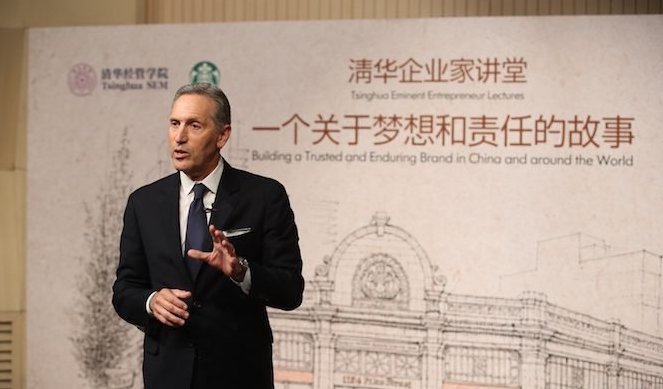
Howard Schultz gave a speech at Tsinghua University, and this time he made a live broadcast.
In addition, he added: "this means that the retail industry is in urgent need of a big adjustment, many brick-and-mortar stores will be closed, and we have to build better, emotionally appealing, romantic stores."
What Schultz is referring to is the Starbucks "Global selection" program and the "coffee roaster" that he is promoting, which are the fresher and seemingly more high-end new business type, showing how Starbucks is at this point in time. To deal with the midlife crisis that has come.
Coffee roaster: maybe the future of Starbucks
What does the so-called "coffee roaster" look like? In May 2016, Starbucks announced that it would open a Starbucks coffee roaster and selection restaurant ("Roastery & Tasting Room") in Shanghai at the end of 2017, the second of its kind.
In 2014, Starbucks opened a coffee roaster in Seattle, USA, where it originated: it covers an area of 15000 square feet (1393 square meters). The architectural style pays homage to the 1920s, with two coffee bars, a theme store, a tall library and a transparent coffee roasting kitchen.
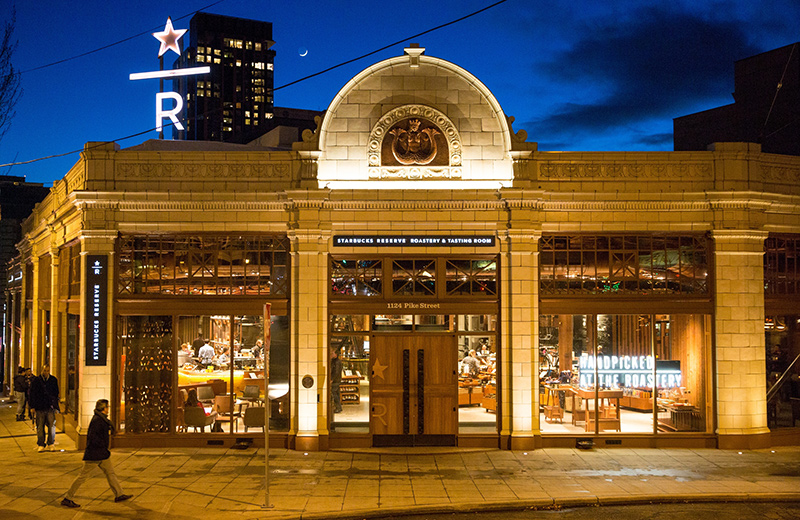
Coffee roaster Seattle store location, using materials from old buildings
Here, customers can see the coffee beans being sent into the roaster, into the large copper stove about 10m high, and then to the whole process of boiling, and can choose various cooking methods such as hand-brewing, legal pressure, siphon and so on. You can also taste seasonal pizza, desserts, salads and other dishes developed jointly by Starbucks and famous local chefs. The new menu not only offers a richer variety of coffee, but also some of the latest selection drinks will be launched here.
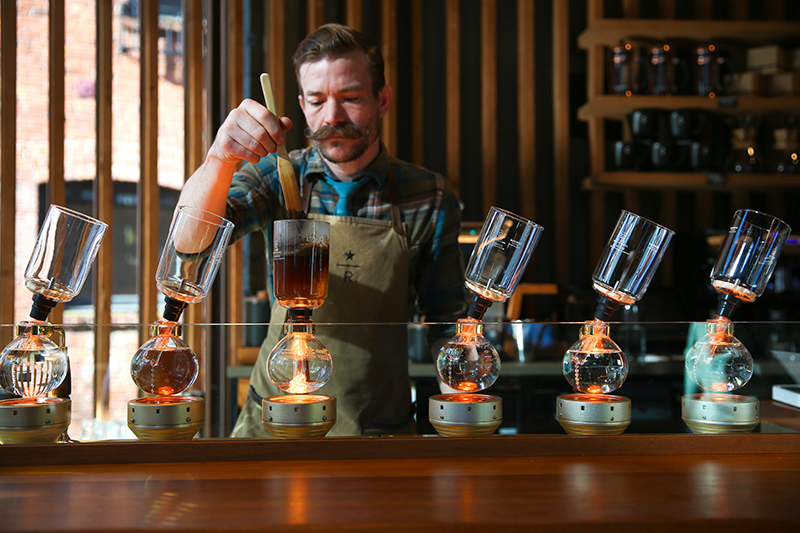
In a coffee roaster in Seattle, a barista is making coffee in a special way.
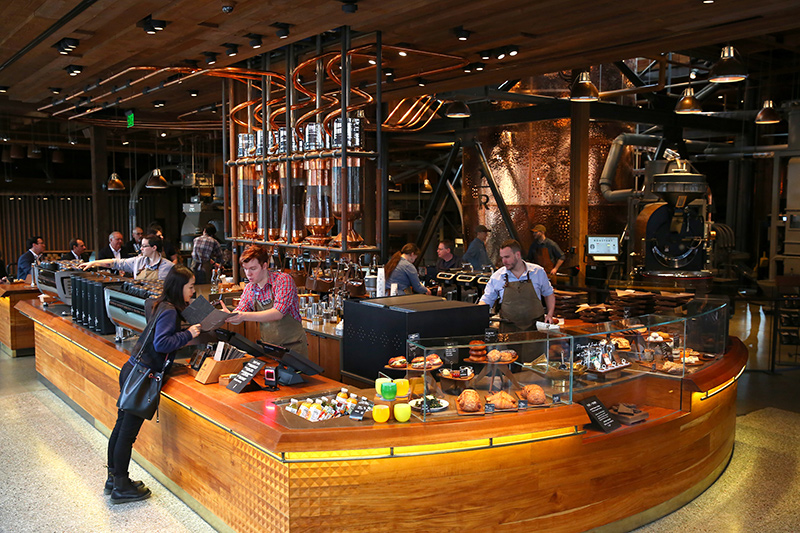
A view of the bar of the coffee roaster in Seattle
In Schultz's words, the coffee roaster is "a magic carpet of coffee, drama and romance", and he wants to develop it into an independent, high-quality brand. In his view, it is the next generation of retail experience that will help Starbucks cope with the challenges of future brick-and-mortar stores.
Starbucks has higher expectations for a new coffee roaster to open in Shanghai. First of all, its larger area-reaching 2700 square meters-will provide exactly the same experience as the Seattle store. It will be located in one of the busiest business districts in Shanghai, located in the soon-to-be-built Taiguhui of Nanjing West Road. The latter is positioned as a high-end retail complex.
It may not be easy to prepare to open such a flagship store. After the opening of its first coffee roaster in 2014, Starbucks planned to open more such stores in New York, Washington and other places, bringing it to 100 within five years. In April 2016, Starbucks announced that a bakery store would appear in New York, with an estimated size of 2000 square meters, but there was no further information.
Of course, based on the fact that Starbucks has a large number of fans in China, it may also be the most sensible decision to open in Shanghai. Not long ago, when the domestic tea brand "Xi Cha" entered Shanghai for the first time from southern China, it triggered a queue for hours and attracted a large number of "scalpers". It seems that Starbucks high-end stores with a strong brand base may become a new "online celebrity sign-in mecca", but it is still unknown whether Chinese consumers' enthusiasm for this experience can continue and what impact and change it will have on other ordinary stores.
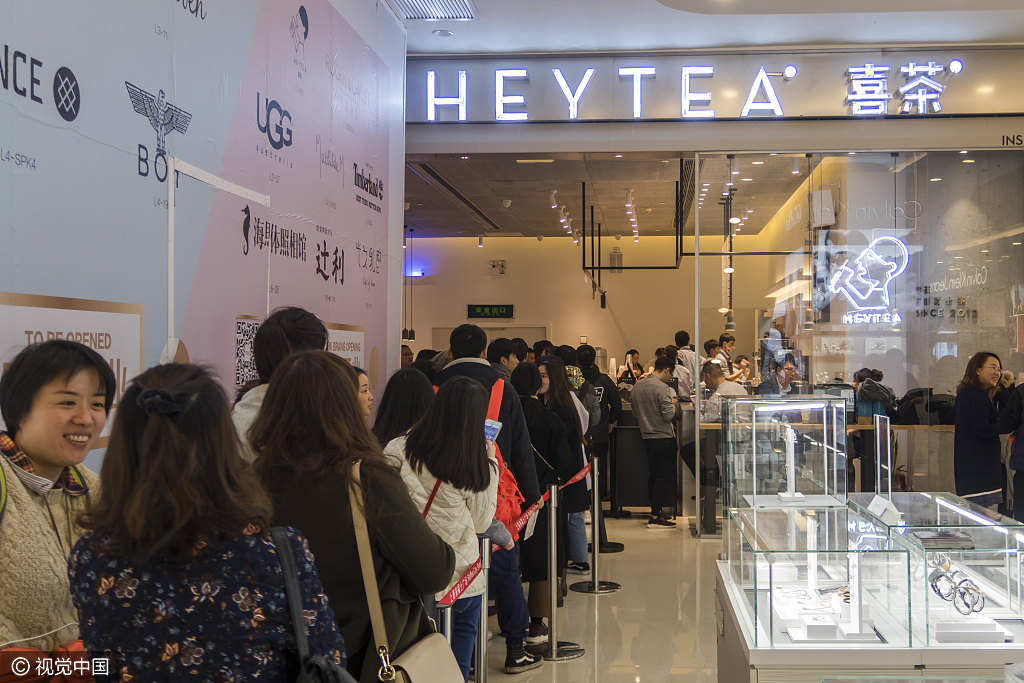
The grand queue of Xi Tea outside the Shanghai people's Square
Starbucks Zhenxuan: black apron, hand punch and exclusive logo
In fact, on the morning of the speech at Tsinghua University, Schultz and Wang Jingying, CEO of Starbucks China, also appeared in Beijing 798, the platform for a Starbucks Zhenzhen store that has not yet officially opened, which is currently second only to the coffee roaster.
Over the past six months, high-end has been the focus of Starbucks and the core business that Schultz will be in charge of after resigning as CEO. In December 2016, Schultz said on a conference call that he would devote himself to the future layout of Starbucks-developing a high-end coffee business and expanding Starbucks brands and stores around the world.
Unlike most dark Starbucks stores in China, 798 Zhenxuan stores use wood elements on the first floor and hot cement and brass materials on the walls and stairs. "World online Merchants" also noted that since the end of 2016, most of the new Starbucks stores have adopted wooden stools to replace the original iron leather surface material, and the interior decoration is also warmer.
Starbucks Zhenxuan store has a common name, called "black apron shop". This is because exclusive Zhenxuan coffee beans are served only in Zhenxuan stores, and there are more black apron "coffee masters" (different from ordinary baristas in green aprons) than the average store with a hand-made coffee table. They will lead consumers to experience contestants making coffee.
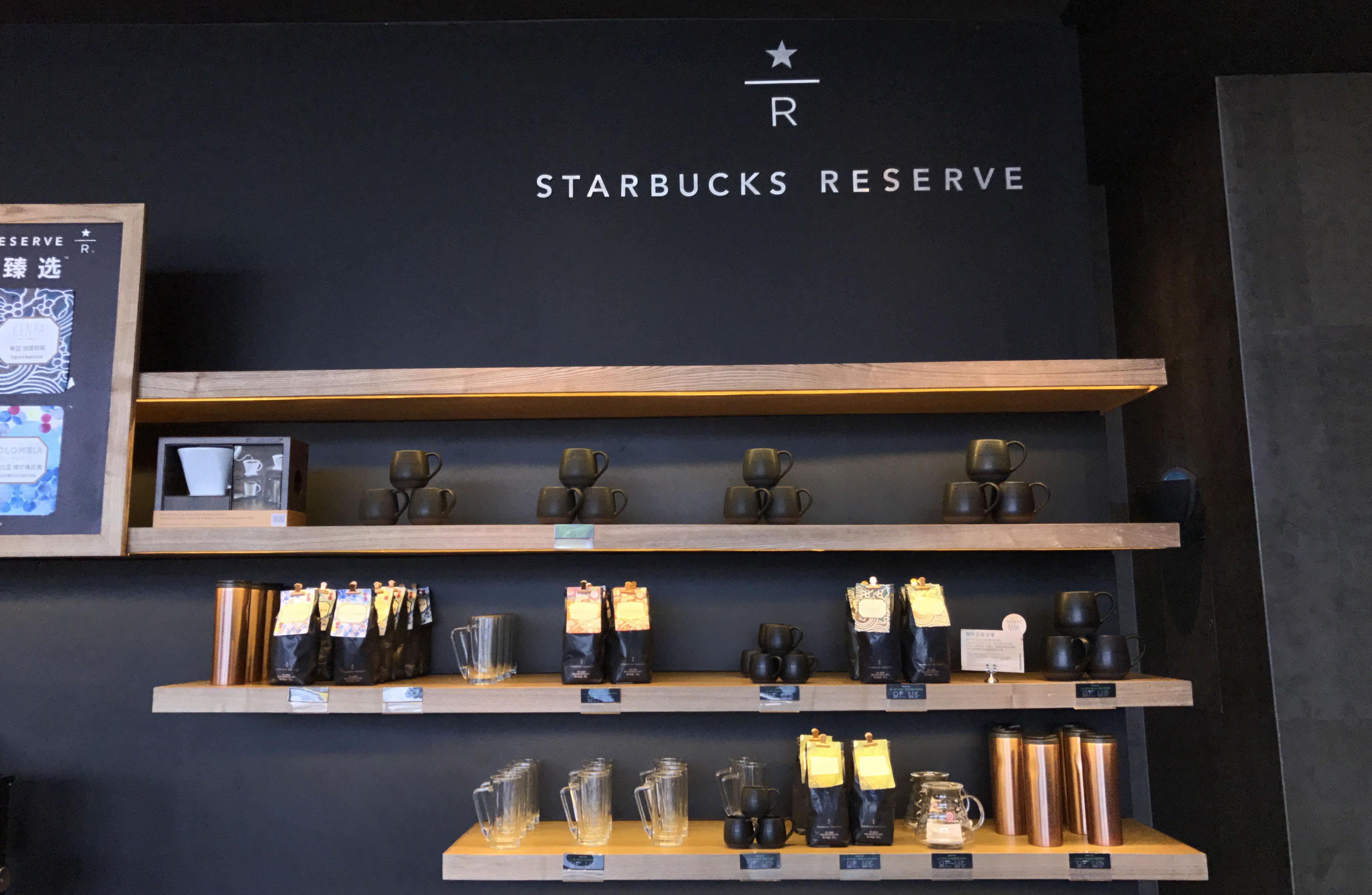
The exclusive logo of Starbucks Zhenxuan store
Starbucks likens Zhenxuan to a "coffee theater" because hand-brewed coffee is more ornamental than machine extraction and tests the baristas' skills. Outside Starbucks, not every cafe has the power to offer good hand-brewed coffee.
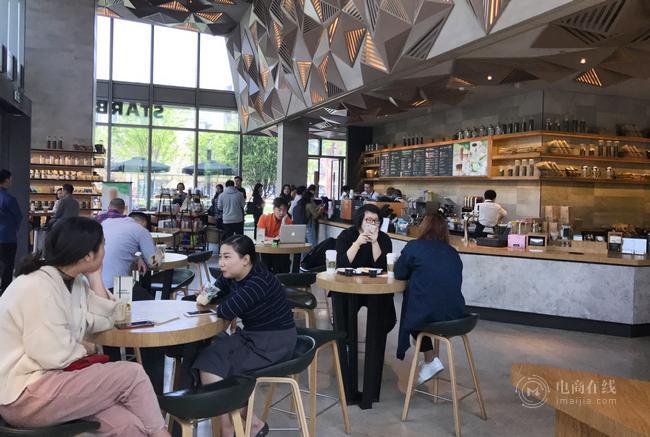
Starbucks Hangzhou Kerry Center Store is also a selection store with more exquisite interior design and open photography / bags.
At the same time, Starbucks Zhenxuan also has a completely different visual design: the black background and white words "R prefix" logo can be seen everywhere in the store, with the words "Starbucks Reserve" underneath, and the porcelain cups are also exclusive logo with black belts. The area of Zhenxuan store is generally larger, and the location is more inclined to the core business district.
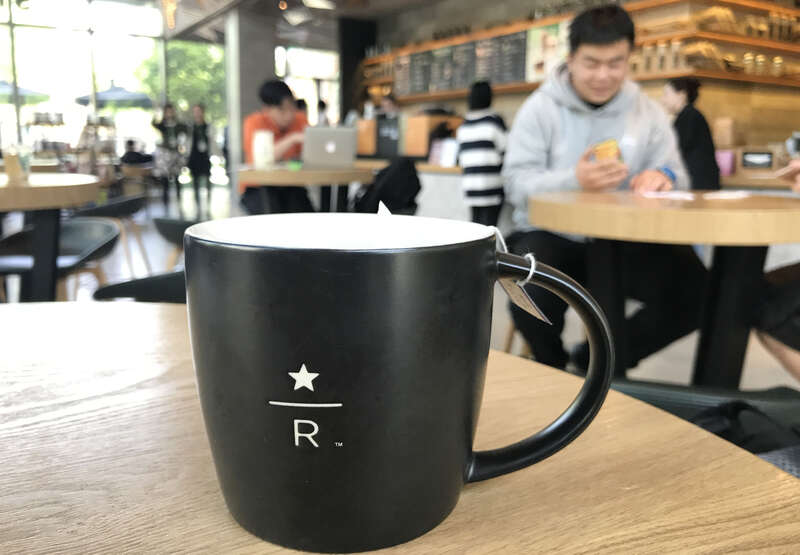
Starbucks Zhenxuan exclusive coffee cup photography / bag
The Starbucks Zhenxuan store officially launched on Chinese mainland in October 2014. in the registration information on the Starbucks website, it has quietly opened 61 stores in 22 cities, including 8 in Beijing, 6 in Shanghai and 2 in Hangzhou. there are generally 1 or 2 stores in second-and third-tier cities.
But the 61 Zhenxuan stores are not exactly the same, four of which are officially defined as "flagship stores" by Starbucks, located in Beijing Kerry Center, Beijing Taiguri, Chengdu Taiguri and Shanghai Disneyland. These four stores not only provide the unique hand experience of Zhenxuan store, but also integrate more cultural elements into the interior design. According to Starbucks officials, the storefront of the Kerry Center store in Beijing uses traditional ink-and-ink paintings and blue-and-white porcelain fragments, while the Shanghai Disney store is a circular dome with an island bar.
In order to serve more picky coffee lovers, Schultz is ready to move a larger "coffee roaster" to China. However, a Starbucks manager told the "World online Merchants" reporter that such store classification does not mean the level of high or low, but only represents different store forms.
Expansion speed or operation quality? This is a problem.
Schultz's eagerness to promote the construction of "high-end stores" does not seem hard to understand, as life has really been tough for US brick-and-mortar retailers these days. According to foreign media reports, among several large chain retailers in the United States, Macy's has announced that it will close 100 stores in 2017, accounting for about 15% of its total stores. Sears plans to close 30 Sears and Kmart stores by April 2017, and CVS has also announced that it will close 70 stores.
Starbucks has stumbled on the same issue. In the second half of 2007, Starbucks declined because of a serious decline in the quality of its operations as it expanded from 1000 to 13000 stores in a few years. Schultz also admits that excessive expansion has led to the dilution of the Starbucks experience.
In January 2008, Schultz was appointed in the face of danger and returned to the position of CEO again. But in the wake of that year's financial crisis, Starbucks eventually closed 600 stores and cut 12000 jobs, and in the third quarter of 2008 the company even posted its first loss since going public.
In contrast, Chinese mainland's development process appears to be relatively smooth. Since the media "Wangwangpu" said in a widely reprinted "store opening success rate of nearly 100%, Starbucks executives personally taught the six principles of store location", after entering Chinese mainland in 1999, Starbucks' success rate is close to 100%.
Gong Ming, director of the public affairs department of Starbucks China Central and Western District, said in an interview that the secret of Starbucks' high success rate in opening stores in China is to first lay out cities from top to bottom, then choose convenient transportation, and set up mature business circles to open multiple stores, targeting high-and middle-income people with higher education.
The reporter searched for news about "Starbucks closes shop in China" and found only four related reports: in July 2013, Starbucks moved its store on the first floor of China's International Trade Mall in Beijing to International Trade Phase III, or due to rising store rents; Starbucks'"Shanghai first store" Libao Plaza, which opened in 2000, quietly closed on May 31, 2009. In 2015, the Starbucks store on Quancheng Road in Jinan was closed due to the withdrawal of Yum Mall from Jinan. In the same year, Starbucks'"first store" in Shaoxing, Zhejiang Province was also suddenly closed on the grounds that the lease had expired.
Zhao Jinliang, founder of "Black hand delivery", which is mainly bought by Starbucks, told the World online Merchants that Starbucks' profits in China, in addition to income from coffee, are actually playing a real estate business similar to McDonald's: because the brand is strong, you can lease the store for a long time with a lower rent. Starbucks has also made huge deposits by selling Starbucks cards and prepaid star cards and customized Visa cards around the world. In June 2016, StarCards had 12 million users in the US market, pushing total deposit deposits to $1.2 billion, according to Sipp Global Market Intelligence, an affiliate of the Wall Street Journal.
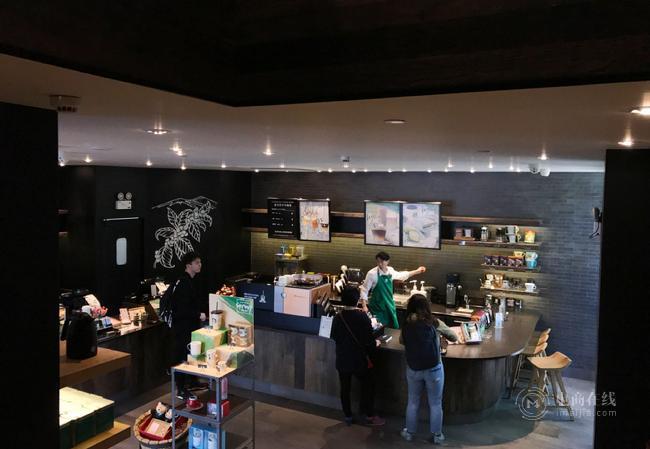
Starbucks opened a new community store on the outskirts of Hangzhou, the location is relatively remote, usually the flow of people is not high photography / bags
Out of optimism about the consumption potential of the Chinese market, Starbucks continues to make great progress. When Starbucks announced the appointment of Wang Jingying, president of China, as its chief executive in China in October 2016, it announced plans to double the number of stores in China from more than 2300 at that time to 5000 by 2021. In 2011, Chinese mainland had only 400 stores.
Since then, Starbucks can be described as "unstoppable". It has become like a convenience store like 7-Eleven or the whole family, which can be seen everywhere: there are at least four Starbucks stores at Beijing South Railway Station alone. there are as many as seven at Shanghai Pudong Airport. In China, where there is no coffee culture, when consumers want coffee, or even just find a place to rest their feet and surf the Internet, the highly standardized Starbucks has become an easy-to-reach safe choice.
The same standardized store decoration can give consumers a sense of trust. Starbucks stores are generally based on black and yellow, while tables and chairs are mainly made of iron and wood. In every store, you can always see long ordering lines, and customers who don't want to leave occupy seats, meet and chat or read and surf the Internet.
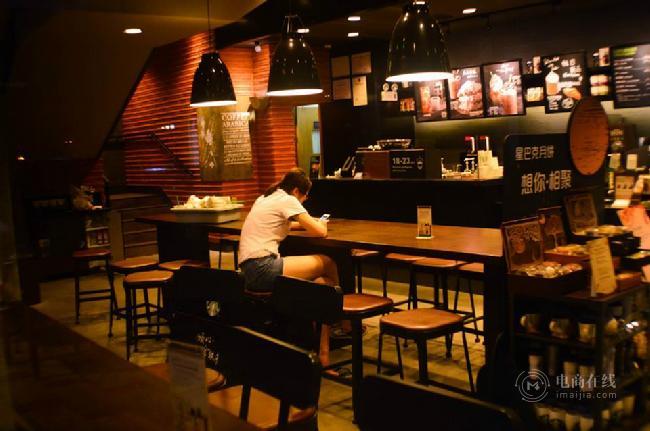
The usual Starbucks seat style
In fact, with the rapid expansion in recent years, most Starbucks stores have begun to look a little boring. To show new ideas, Starbucks has been setting up stores with local characteristics in different regions, such as the Sinan residence, an old house in Shanghai, and the former residence of Jiang Jingguo near the broken Bridge in Hangzhou, into Starbucks Coffee.
However, this does not change Starbucks' pursuit of a high turnaround rate, as evidenced by the uncomfortable tall wooden stools and the fact that shop assistants rarely offer porcelain cups. Compared with boutique cafes with well-decorated and comfortable seats, Starbucks seems to be losing its say on the "taste" of coffee in China.
What else did Starbucks do not want to be reduced to "fast food coffee"?
Starbucks does not want to be reduced to "fast food coffee". In order to prove its coffee quality, the company announced in early 2016 that it would open a store in Italy, which has a strong coffee culture, and plans to open its first store in early 2017. Percassi, a Starbucks agent in Italy, recently postponed the project until 2018.
In addition to coffee, Starbucks has made a variety of investments and acquisitions since 2013. In addition to setting up its own cold-pressed juice factory in the United States, it spent a total of $750 million to acquire three brands: Evolution Fresh Juice, Brown Hot Bakery (La Boulange) and Teavana Teahouse, which entered China in August 2016.
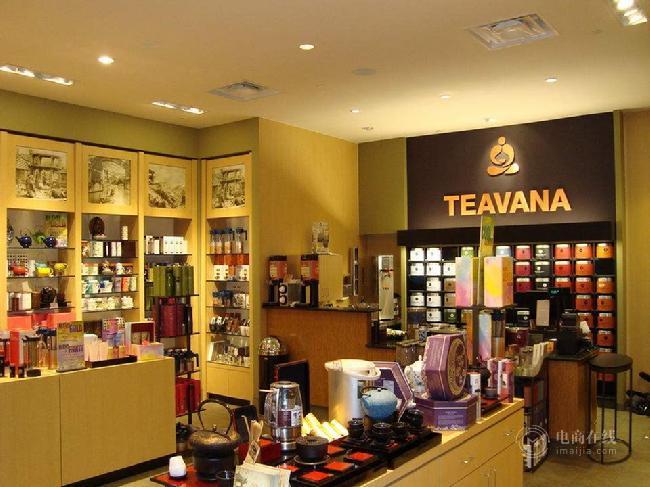
Teavana teahouse, whose drinks are also sold in Starbucks stores
In July 2016, Starbucks also invested in Italian restaurant brand Princi and plans to introduce exclusive food from Princi in two new Starbucks coffee roasters, including Shanghai and New York.
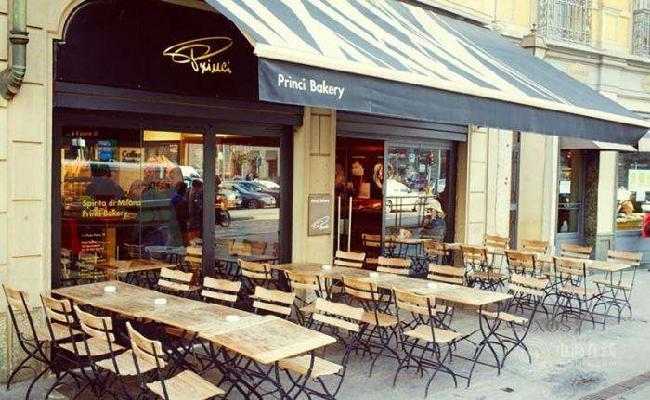
Princi stores in Italy
This is Starbucks' first attempt to offer food baking in stores. "We have never baked food in Starbucks stores in 45 years, and this unprecedented partnership will change all that," Schultz said. Princi Foods will further enhance the experience of customers at Starbucks Coffee Roasters and selection restaurants-whether it's breakfast, lunch or dinner. "
Founded in 1986, Princi is a brand that started with hand-baked products and is known for its 24-hour business, offering a wide variety of breads, cakes, fruit tarts and other foods, as well as coffee and alcoholic beverages.
The characteristic of Princi is that, like Starbucks, each store has a unique decoration style and characteristics according to its location. In terms of consumption, it is positioned as "light extravagance", and the price is about 50% higher than similar products. According to founder Rocco Princi, Princi's bread uses only natural yeast, spring water, organic flour and salt.
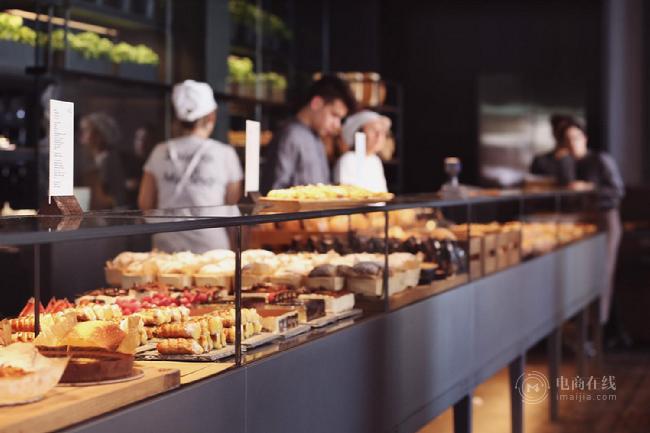
Princi is famous for offering a wide variety of high-quality bread, cakes, fruit tarts, etc.
It remains to be seen whether Princi can help Starbucks roasters become more competitive. But the truth is, Starbucks already faces competition from many boutique coffee chains in the U. S. market. According to the New York Times, typical examples include Stumpton Cafe (Stumptown Coffee Roasters), Dilanos Coffee roasting Company (DillanosCoffee Roasters) and Blue bottle Coffee (Blue Bottle Coffee).
In China, Starbucks competes with Korean coffee brands such as Costa coffee and Caffe Bene, which are also coffee chain giants, as well as potential new online celebrity tea brands such as Xi Cha, although the latter is still a far cry from Starbucks.
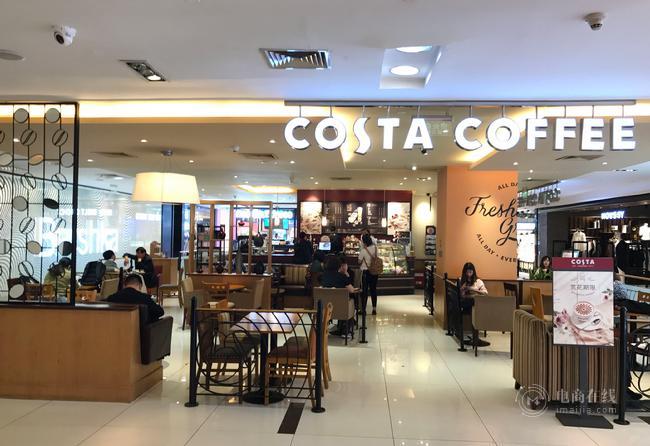
Costa Coffee Hangzhou Lixing Store is also one of the earliest Costa stores opened in the city. Photography/bags
Starbucks needs to address its own negative experience.
In November 2016, shortly after Wang Jingying was promoted to CEO of Starbucks China, an open letter to Wang Jingying, CEO of Starbucks China, exploded the circle of friends and caused discussion about the "middle cup door". The article mentioned that when the Hangzhou consumer consumed at Starbucks, the clerk asked "Are you sure it is a medium cup? The medium cup is our smallest cup type" to imply that consumers buy large cups, whether to buy cakes at a 20% discount price, whether to do star cards and other promotional behaviors, which really bring bad experiences to consumers.
Starbucks, on the other hand, encourages customers to queue horizontally, in an article published by the media Happy Caterer, Starbucks queues horizontally, McDonald's queues vertically? The secret behind the restaurant line design is…"mentioned that such a setting is conducive to optimizing the workflow from ordering to coffee, making full use of sales space to display products, and alleviating consumer anxiety.
To improve the efficiency of checkout queues, KFC and McDonald's have begun to vigorously promote self-ordering, and the latter even separates ordering and picking up meals, in contrast to the long lines that often occur in Starbucks stores, which deter consumers who are in a hurry.
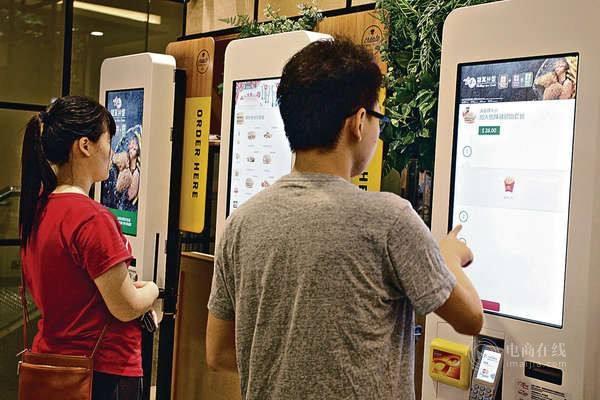
McDonald's is now vigorously promoting the buffet machine.
At the Swiss bank's Global consumption and Retail conference in March 2017, Starbucks CFO Scott Maw said it was trying to address the negative experience of queuing for meals, Curiosity Daily reported. The solution is to add more staff in the short term, but in the end, we have to change the design of the space in the store.
From 2016 to 2017, Starbucks China has also made many attempts in online and offline integration, mobile payment, social consumer experience, personalized store experience, and so on.
For example, Starbucks Shanghai Disney Store has removed the traditional "menu blackboard". In order to improve the efficiency of cashier ordering, each customer will receive a "handheld menu". By scanning the Wechat QR code order, the island bar is designed to split the flow of people in two.
In addition, Starbucks opened an official flagship store selling electronic exchange coupons in Tmall as early as December 2015. Nearly 2500 Chinese mainland stores were connected to WeChat Pay on December 8, 2016 and joined Wechat to try out social gifts in early 2017.
At present, China has become Starbucks' largest overseas market. At Chinese mainland, Starbucks has more than 2600 stores in more than 120 cities and employs nearly 40, 000 people. What new retail format will Starbucks develop in the future? This may be the next question Schultz needs to consider.
(editor / Wu Sifan)
Important Notice :
前街咖啡 FrontStreet Coffee has moved to new addredd:
FrontStreet Coffee Address: 315,Donghua East Road,GuangZhou
Tel:020 38364473
- Prev
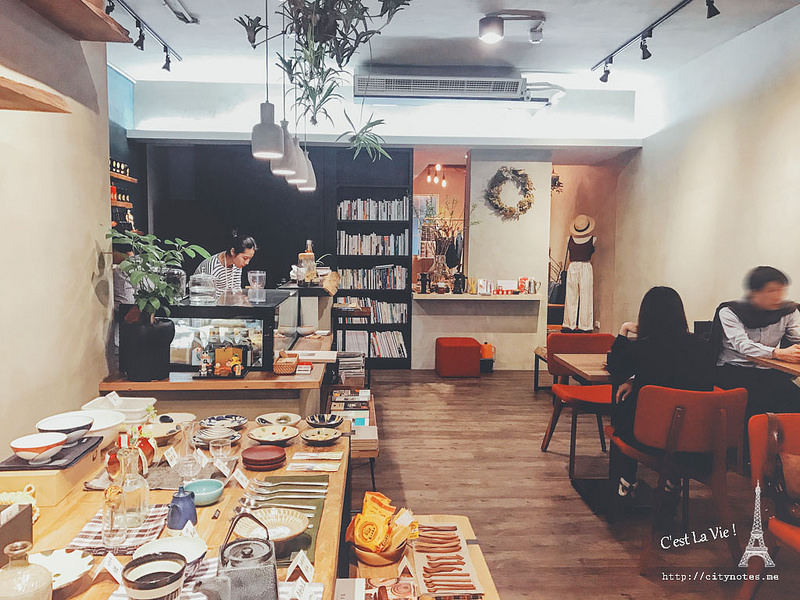
Cake, coffee, tea and full of Japanese pottery, utensils home-- pottery coffee / tea
It is not easy to make style a good thing. Although there are numerous coffee shops in Taipei, each of them can find different changes, but very often it is very difficult to clearly define style. For example, I decorate my house in Nordic style, but the floor actually belongs to the gentle wind series. For example, if I buy a wrought iron chair one day, it will change again.
- Next

In Sanlitun, there is a coffee machine with less than 20 units in China.
Alex Bros is a cafe that is so rich and diverse that you will get a harvest every time you visit. Avant-garde and art Alex Bros has a very advanced coffee machine SteamPunk steampunk. This coffee machine costs six figures and no more than 20 in the country. As for Beijing, there are only about five. Steam heat the water in the pot, reach the set temperature, pour coffee powder at the top, press and filter
Related
- What documents do you need to go through to open a coffee shop? coffee shop coffee shop certificate processing process
- How to purchase Coffee beans in small Cafe how to choose a suitable supplier for domestic Coffee supply Company
- How to drink Starbucks Fragrance White Coffee? how to make Australian White Coffee? what Italian coffee beans are recommended?
- The Story of Flora Coffee: the name of Flora Coffee Bean and the implication of the Flowers on Florna Coffee
- How much does a cup of coffee cost? How much is the profit of a cup of coffee? What is the profit of the coffee shop in a year?
- Yunnan small Coffee, known as "fragrant Coffee", introduces the characteristics of Alpine Arabica Coffee producing areas in Yunnan, China
- 2023 latest Starbucks full menu price list how much is a cup of Starbucks coffee what is better to drink the most popular hot and cold drinks recommended
- Starbucks different kinds of Coffee Price list Starbucks menu 2023 Top Ten Best drinks in Starbucks
- Starbucks Spring praise Comprehensive matching Coffee Bean theme Story Packaging implication and taste description
- The cost of a cup of coffee latte American coffee cost price and selling price

